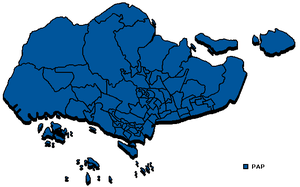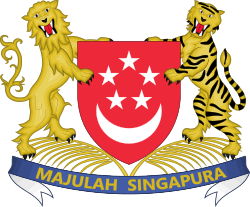1980 Singaporean general election
General elections were held in Singapore on 23 December 1980. The result was a victory for the People's Action Party, which won all 75 seats, the last of four consecutive elections in which they repeated the feat. Voter turnout was 95.5%, although this figure represents the turnout in the 38 constituencies to be contested,[1] with PAP candidates earning walkovers in the other 37. 685,141 voters out of the total electorate of 1,290,426 went to vote on the elections.
| ||||||||||||||||||||||||||||||||||
All 75 seats to the Parliament of Singapore 38 seats were needed for a majority | ||||||||||||||||||||||||||||||||||
|---|---|---|---|---|---|---|---|---|---|---|---|---|---|---|---|---|---|---|---|---|---|---|---|---|---|---|---|---|---|---|---|---|---|---|
| Turnout | 95.5% | |||||||||||||||||||||||||||||||||
| ||||||||||||||||||||||||||||||||||
 Winning party by constituency | ||||||||||||||||||||||||||||||||||
 |
|---|
| This article is part of a series on the politics and government of Singapore |
|
|
|
Related topics |
|
|
Background
Prior to the election, a series of by-elections were called on 1977 and 1979 after two and seven MPs, respectively, were vacated; however, the ruling PAP won every seat, allowing nine new candidates, which include Devan Nair and Tony Tan (both would later went on to become Presidents of Singapore) to enter Parliament.
On 2 April the following year, then-President of National Trades Union Congress, Phey Yew Kok, resigned his Boon Teck seat after Phey was initially charged from a funding fraud of trade union funds, and left Singapore to avoid a bail; however, Lee chose not to call a by-election in his place since the current Parliament term was due to end.
Timeline
| Date | Event |
|---|---|
| 5 December | Dissolution of 4th Parliament |
| 13 December | Nomination Day |
| 23 December | Polling Day |
| 3 February 1981 | Opening of 5th Parliament |
Campaign
The school streaming system, as well as Phey Yew Kok's fraud, became highlights of the campaign for the election.
Independent candidate Chiam See Tong, who made his political debut in the previous election, founded Singapore Democratic Party on 8 September, and would later go on to win Potong Pasir Constituency on the 1984 election on his third attempt (his first attempt was in the by-election last year) after the retirement of incumbent and cabinet minister Howe Yoon Chong.
A total of 43 opposition candidates went on to contest in 38 constituencies, which was nearly half of the total, with United People's Front representing the most number of candidates at 14. This was the first election (of the only three in history, with the other being 2006 and 2011) none of the candidates run as Independents.
Constituencies
Similar to previous elections, constituencies were either dissolved or created due to population. The constituencies which saw changes were:
| Constituency | Changes |
|---|---|
| New Constituencies | |
| Ayer Rajah Clementi West Coast | Carved from Bukit Timah |
| Cheng San Chong Boon | Carved from Serangoon Gardens |
| Kaki Bukit | Carved from Kampong Chai Chee |
| Kebun Baru Yio Chu Kang | Carved from Ang Mo Kio |
| Tanah Merah | Carved from Bedok and Changi |
| Defunct Constituencies | |
| Farrer Park | Ward was absorbed to Moulmein |
| Geylang East | Ward was absorbed to MacPherson |
| Upper Serangoon | Ward was absorbed to Punggol |
Results
| Party | Votes | % | Seats | +/– |
|---|---|---|---|---|
| People's Action Party | 494,268 | 77.7 | 75 | +6 |
| Workers' Party | 39,590 | 6.2 | 0 | 0 |
| United People's Front | 28,586 | 4.5 | 0 | 0 |
| Singapore United Front | 27,522 | 4.3 | 0 | 0 |
| Barisan Sosialis | 16,488 | 2.6 | 0 | 0 |
| Singapore Malay National Organisation | 13,435 | 2.1 | 0 | 0 |
| Singapore Democratic Party | 11,292 | 1.8 | 0 | New |
| Singapore Justice Party | 5,271 | 0.8 | 0 | 0 |
| Invalid/blank votes | 17,743 | – | – | – |
| Total | 654,452 | 100 | 75 | +6 |
| Registered voters/turnout | 685,141 | 53.1 | – | – |
| Source: Nohlen et al. | ||||
References
- Dieter Nohlen, Florian Grotz & Christof Hartmann (2001) Elections in Asia: A data handbook, Volume II, p254 ISBN 0-19-924959-8
.jpg)